When I first heard Rigs Fly Shop (a Tenkara USA dealer here in Colorado) was coming out with a new level line, I wasn’t really all that interested. After all, how much can you really innovate a level line? But when I first laid eyes on it, I knew it was something special. And when I first fished it, I got excited and knew it was unlike any other tenkara line I’d ever fished.
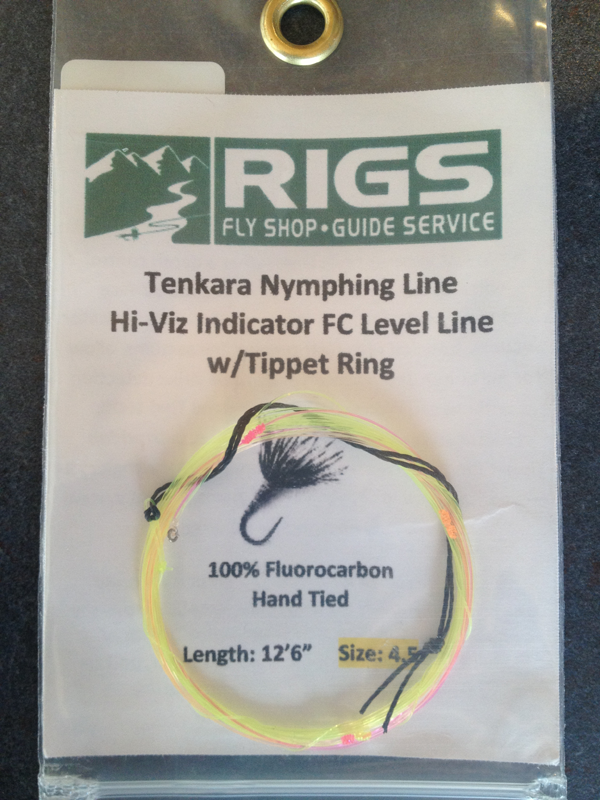
Most tenkara level lines are nothing more than a length of fluorocarbon with knots tied at each end to secure the tippet to the line and line to the rod. The first thing that’s evident about this line is that it’s much more than a straight piece of fluorocarbon. It’s engineered!
The main line appears to be yellow Tenkara USA level line. If you read my review of this line, you’ll know why I think this was a good choice as a foundation (spoiler: good visibility and low memory).
Instead of a slip knot tied in the end, the Rigs line uses a girth hitch connection similar to the one I use on some of my level lines (though it’s not Dacron). I’m not sure what the material is, but I like it. It’s very easy to connect and disconnect from the lilian. While the 12′ 6″ length is a little short for my taste, they did something really clever. Rather than being knotted in, the transition loop is actually connected to another loop in the main line with another girth hitch connection. So, if you want to lengthen the line, all you have to do is remove the transition loop, add more line with a loop-to-loop connection, and replace the transition loop:
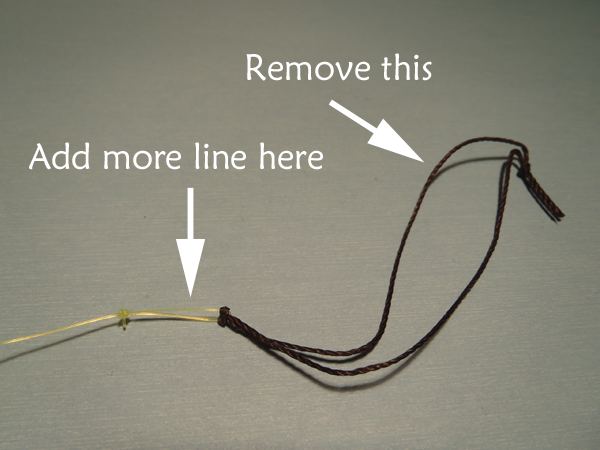
These are nice touches, but for me, the real innovation comes at the business end of the line. It features alternating sections of clear, hi-vis pink and hi-vis orange with (maybe barrel?) knots tied in between. You would think that the sections would be more visible, but it’s actually the knots that serve as micro “strike indicators” to provide the best visibility:
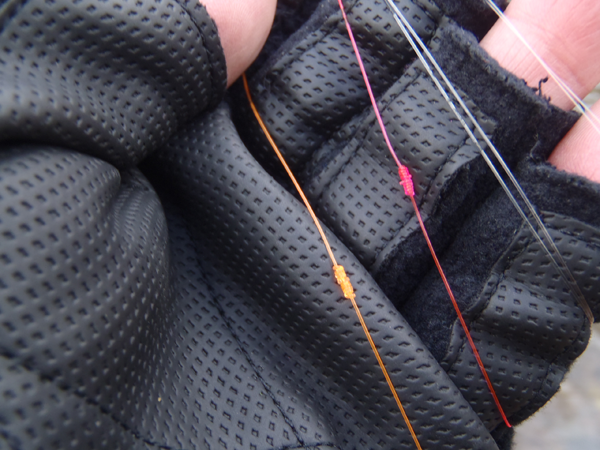
Despite a grey, hazy day of testing, the knots were always visible–in low light, “dark” water, and against glare. Even the most subtle strikes are detectable with this line.
The picture below doesn’t do it justice but I tried to capture it on the water:
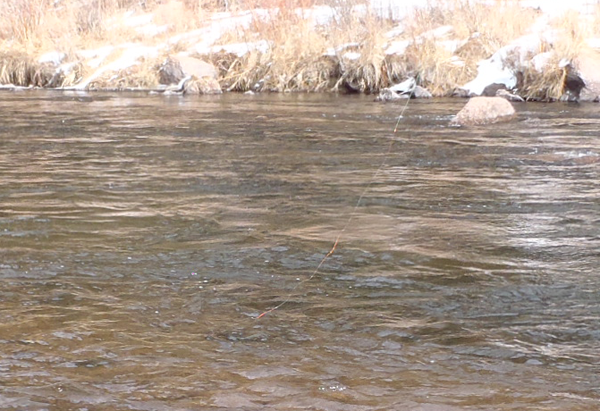
I like everything about this line except one thing: the tippet ring. While it might seem like a nice finishing touch, I believe tippet rings actually cut tippet and lose fish. In my field test, I didn’t cut off the ring but I used it more as a stopper knot and just connected my tippet with a slip knot like I normally do (it basically acted as the figure 8 knot I normally tie in the end of my level lines). If there were one recommendation I would make to Rigs to improve this line, it would be to drop the tippet ring. Just use a figure 8 instead.
Lastly, some might get sticker shock when they see the price. I did too at first. But then, I thought about all the testing, all the work, all the sourcing of materials that went into it. And then I thought of the experience. When I put that together, the price seemed more than reasonable. And when I compared it to the price of most flylines today (about 1/3 the cost for a mediocore one), it seemed like a steal! Unlike conventional fly lines, you won’t have to replace this one every season or two. It will last until you lose it.
This is hands down the best tenkara level line I’ve used for subsurface presentations and has the best visibility. It turns over nicely (even in the wind) and is easily tracked. What more could you ask for? For more info or to buy, click here.


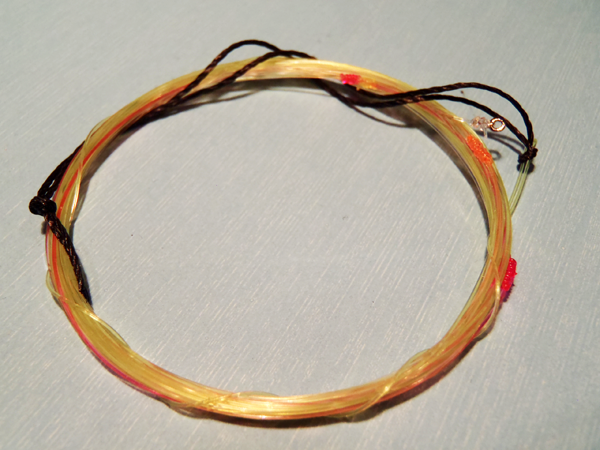






Hey Jason,
I’m impressed with how visible those knots are even in the picture. I’ve tried a few level lines and find myself coming back to furled lines. I may have to get one of these though. I will second the motion of no tippet rings though I don’t like how it creates a hinge point in the line. Hope you had a good x-mas and happy new year!
Hey Lance, furled lines turn over nicely and are great but you can’t really adjust the length with most of them. That’s why I like level lines. I can automagically turn a 12 ft. line into a 20 ft. line if I need to. Much more flexible. I like how Rigs built this versatility into their lines. Pretty damn good design IMHO.
I’ve been using tippet rings for 20 years or more and do not recall a tippet ever coming off at teh ring adn I don’t notice any hing. Maybe it is how they are tied in.
Brian, which knot and tippet size are you using?
Thank you Jason this is one of two reviews that I had waing for, the second, of course, is to the Rigs Tenkara floating line.
Regards.
Hi Vasco, I’ve got the floating line too and am working on that review. I will post it soon but I’ll give you a preview: it’s another winner from Rigs!
My wife gave me for Christmas gift a voucher: “valid for Tenkara line purchase in U.S.”, now I know in what I will use.
Regards.
I recently do Kebari-tsuri like nymphing.
As on this fishing,visible line is really hated with fishes,
so I use full of un visible line attached 2~3marker at about
middle of the line.
This style is similar to “Myaku-zuri” which is Jps bate fishing method
for Yamame,Iwana or some,and the method is also similar to nymphing,
I think,just only I think and just only my case.
Excelente informe,gracias….
Jason,
Have you changed your method of putting pictures in your blog? Up until this Rig blog I have always highlighted your article and pictures, copy and paste it into a document file. This one, the pictures did not copy, the text did.
Hi Eddie,
NO, I didn’t change anything. I don’t know why the pictures aren’t copying. But If you want, I can email the pictures to you.
Thanks, Got it figured out.
Eddie
Great post and great idea with the line. I’ve been messing around with the traditional line to level line connections but the knots and seperate colors is a great idea. I’m with you on the no tippet rings though.
I second Brian’s views. Jason, I’ve actually found the reverse of you. I found that the breaking strain of the terminal tackle was much less using a figure eight knot in the #3 level line and a slip on knot for my FF+ 6x tippet (my standard). I have nearly full strength tippet to line connections when using hanak tippet rings, and an improved clinch knot (5 turns). This season I have switched to the rings almost exclusively for dries, wets (sakasa kebaris) and nymphs. The Hanak rings are light, small, and nickel black.
This season in Australia is much harder than last, and it looks like we are heading back to drought conditions again.
Hi Craig,
Interesting. Every time I’ve tried using tippet rings, I’ve had at least one breakage right at the ring (also using a clinch knot). Luckily, it was always on a snag, not on a fish. Upon closer inspection, I noticed that the rings aren’t perfectly round. They’re kind of square and I suspect that was cutting the line. Three completely different batches were the same. They weren’t Hanak brand. Are the Hanaks round and smooth on the inside?
not sure, can’t see it until I get back to base and get out the the mag glass (in the mountains at present, get cell phone reception when I peak as going over to new valleys and rivers). The package suggests that they are indented, but I can’t see it with my eyes and even with my mag lenses.
I have found on 6x and 5x in Rio FF plus (note, the use the FF plus) that the ring is superior to a line to line connection. It all comes down to the knot and tippet you use – I use the best tippet (and go through it like, well, water) and a knot I can tie that consistently rates at close to tippet breaking strain onthe smaller diam tippets.
Jason,
What TenkaraUSA rod would you use with this line for nymphing? Do you use weight?
Hi Jeff,
I’ve only used it with the Ito so far. You could probably fish it with any T-USA rod but bear in mind it’s a #4.5 so of you’re used to fishing lighter lines it might feel like its overpowering softer rods like the Ayu. It depends on your style and what you’re used to.
I use copper wire on some of my flies to help them sink but I never use split shot or an indicator.
I just tried a little nymphing for the first time last summer on my 12′ Iwana and on some western gear. The books I read all talked about weighted nymphing with bead heads, copper wire and mostly by adding split shot. It said if you didn’t get down to the strike zone, you missed most of the trout.
I take it you aren’t having any problem with that without split shot?
Hi Jeff,
Traditionally, in tenkara you would use an unweighted fly. You use other techniques to get the fly down in the zone. There’s nothin wrong with using a bead head or weighted fly but in my opinion, split shot doesn’t cast very well with tenkara rods. Personally I don’t think it’s necessary but some people do it. Send me an email through the contact form and I can explain more if you want.
I consistenly czech nymph with tenkara rods (actually, it’s short line version of french style, if you can imagine it). I also use tungsten flies for this, to get down quick even with #18’s(shock!).
The iwanas are stiff enough for lobbing a single fly setup up to a 3mm tung bead (but this is pushing it and they are much better with 2.5mm or smaller), and I use them often for small fish rod for low water (sic) nymphing. If the fish are potentially more than 1.5lb, or the water is deeper and higher flows, I use higher rated rods and heavier flies for the nymphing. either heavier flies or bigger fish demand a higher rated rod to get fly to fish and fish to net.
Thanks Jason and Craig for the replies. I feel lucky to have such great resources available while trying to learn the art of Tenkara and to improve at other variations of fly fishing using Tenkara rods. Jason, I just saw your invitation to email you, but I also saw your new article and assume that’s covering much or all of what you would have mentioned. I’ll sign up to get email alerts on replies and posts so I can keep up better in the future. Thanks again to all. Always believed you’ve got to ask questions if you want to learn.